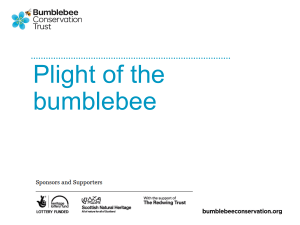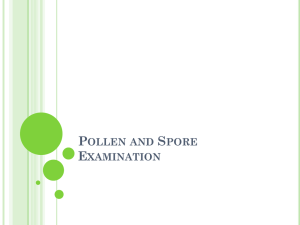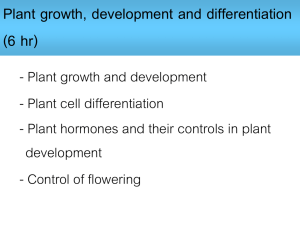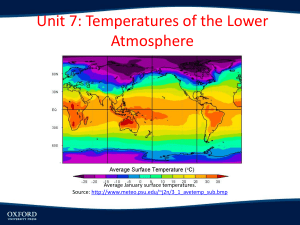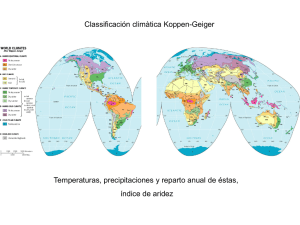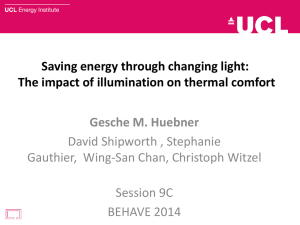Emily Owen`s poster (PPT - 1.16MB)
advertisement
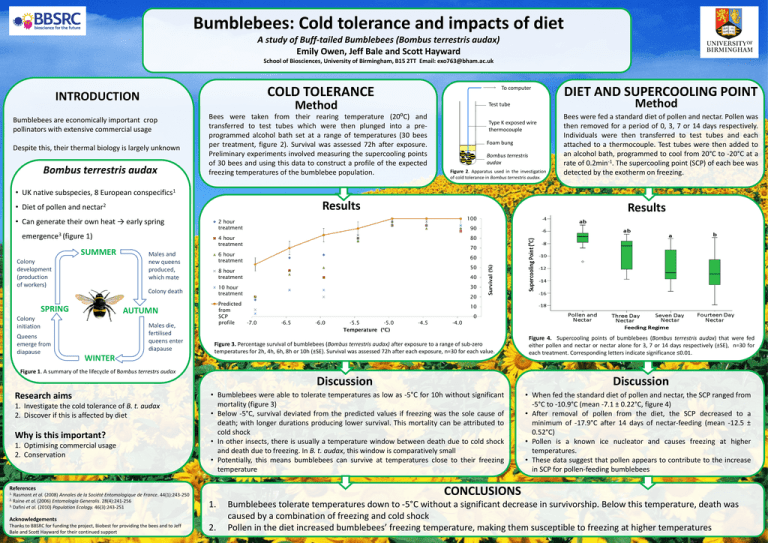
Bumblebees: Bumblebees:Cold Coldtolerance toleranceand andimpacts impactsof ofdiet diet AAstudy studyofofBuff-tailed Buff-tailedBumblebees Bumblebees(Bombus (Bombusterrestris terrestrisaudax) audax) Emily Owen, Jeff Bale and Scott Hayward Emily Owen, Jeff Bale and Scott Hayward School of Biosciences, University of Birmingham, B15 2TT Email: exo763@bham.ac.uk School of Biosciences, University of Birmingham, B15 2TT Email: exo763@bham.ac.uk COLD TOLERANCE COLD TOLERANCE Despite thermal biology is largely unknown Despite this,this, theirtheir thermal biology is largely unknown Bombus terrestris audax Bombus terrestris audax 2 hour 2 hourtreatment treatment 4 hour 4 hourtreatment treatment 6 hour 6 hourtreatment treatment 8 hour 8 hourtreatment treatment 10 hour treatment 10 hour treatment Predicted from Predicted from SCP -7.0 SCP profile profile -7.0 3 emergence 3 emergence (figure 1) Colony Colony development development (production (production of workers) of workers) SUMMER SUMMER Colony death Colony death SPRING SPRING Colony Colony initiation initiation Queens Queens emerge from emerge from diapause diapause Males and Males and new queens new queens produced, produced, which mate which mate AUTUMN AUTUMN WINTER WINTER Males die, Males die, fertilised fertilised queens enter queens enter diapause diapause Research aims Research aims • 1. 2. • Why is this important? Why is this important? 1. 2. 1. Optimising commercial usage Optimising commercial usage 2. Conservation Conservation References References 1. Rasmont et al. (2008) Annales de la Société Entomologique de France. 44(1):243-250 Rasmont et al. (2008) Annales de la Société Entomologique de France. 44(1):243-250 2. Raine et al. (2006) Entomologia Generalis. 28(4):241-256 2. Raine et al. (2006) Entomologia Generalis. 28(4):241-256 3. Dafini et al. (2010) Population Ecology. 46(3):243-251 3. Dafini et al. (2010) Population Ecology. 46(3):243-251 1. Acknowledgements Acknowledgements Thanks to BBSRC for funding the project, Biobest for providing the bees and to Jeff Bale and Scott Thanks to BBSRC for funding the project, Biobest for providing the bees and to Jeff Hayward for their continued support Bale and Scott Hayward for their continued support of cold tolerance in Bombus terrestris audax. -6.5 -6.0 -6.0 -5.5 -5.0 -5.5 -5.0(°C) Temperature Temperature (°C) 100 100 90 90 80 80 70 70 60 60 50 50 40 40 30 30 20 20 10 10 0 -4.0 0 -4.5 -4.5 Results Results -4.0 Figure 2. Percentage survival of bumblebees (Bombus terrestris audax) after exposure to a range of sub-zero temperatures 2h, 4h, 8h or 10h (±SE). Survival was assessed 72h after each exposure, for each value. Figure 3. Percentage for survival of6h, bumblebees (Bombus terrestris audax) after exposure to a rangen=30 of sub-zero Figure 1. AFigure summary of the of lifecycle of Bombus terrestrs 1. A summary the lifecycle of Bombus terrestrsaudax audax 1. Investigate tolerance of t.B.audax t. audax Investigate thethe coldcold tolerance of B. 2. Discover if this is affected by diet Discover if this is affected by diet Bees were Beesfed were a standard fed a standard diet ofdiet pollen of pollen and nectar. and nectar. Pollen Pollen was Type K exposed wire was then thenremoved removedfor for aa period of of 0,0,3,3,7 or 7 or 14 days 14 days respectively. thermocouple Figure 2. respectively. Individuals Individuals werewere thenthen transferred transferred to to test testtubes tubesand each Foam bung and each attached attached totoa athermocouple. thermocouple.Test Testtubes tubeswere werethen then added to added to anan alcohol alcohol bath, bath,programmed programmedtotocool coolfrom from20°C 20°Ctoto-20°C at a Bombus terrestris -1. The -1. The audax -20°C atrate a rate of 0.2min of 0.2min supercooling supercooling pointpoint (SCP)(SCP) of each of bee was Figure 2. Apparatus used in the investigation each bee detected was detected by the by exotherm the exotherm on freezing. on freezing. Results Results -6.5 • • Method Method Test tube Bees Bees werewere takentaken fromfrom theirtheir rearing temperature (20⁰C) andand rearing temperature (20⁰C) transferred to test tubestubes which werewere thenthen plunged intointo a pretransferred to test which plunged a preprogrammed alcohol bath bath set atseta at range of temperatures (30 (30 bees programmed alcohol a range of temperatures bees per treatment, figure 2).Survival Survivalwas was assessed exposure. per treatment). assessed 72h 72hafter after exposure. Preliminary experiments involvedinvolved measuring the supercooling points Preliminary experiments measuring the supercooling of 30points bees and using data to construct a profile of the expected of 30 beesthis and using this data to construct a profile of the freezing temperatures the bumblebee population. expected freezingof temperatures of the bumblebee population. 1 • UK native subspecies, 8 European conspecifics 1 • UK native subspecies, 8 European conspecifics 2 • Diet of pollen and nectar 2 • Diet of pollen and nectar • Can generate their own heat → early spring • Can generate their own heat → early spring DIETDIET ANDAND SUPERCOOLING POINT SUPERCOOLING POINT Survival (%) Bumblebees economically important Bumblebees are are economically important cropcrop pollinators extensive commercial usage pollinators withwith extensive commercial usage MethodMethod Survival (%) INTRODUCTION INTRODUCTION To computer Figure 3. Supercooling points of bumblebees (Bombus terrestris audax) that were temperatures for 2h, 4h, 6h, 8h or 10h (±SE). Survival was assessed 72h after each exposure, n=30 for each value. Figure 4. Supercooling points of bumblebees (Bombus terrestris audax) that were fed fed either pollen and nectar or nectar alone for 3, 7 or 14 days respectively, n=30 either pollen and nectar or nectar alone for 3, 7 or 14 days respectively (±SE), n=30 for for each treatment. Corresponding letters indicate significance ≤0.01. each treatment. Corresponding letters indicate significance ≤0.01. Discussion Discussion Discussion Discussion • Bumblebees to tolerate temperatures as -5low as 10h -5°Cwithout for 10hsignificant without Bumblebees were were able toable tolerate temperatures as low as °C for significant mortality (figuremortality 3) • Below survival deviated predicted values if freezing sole cause Below -5°C, -5°C, survival deviated fromfrom the the predicted values if freezing waswas thethe sole cause of death; withdurations longer durations lowerThis survival. Thiscanmortality can be death;ofwith longer producing producing lower survival. mortality be attributed to attributed to cold shock cold shock • In other insects, is usually a temperature window between cold In other insects, therethere is usually a temperature window between deathdeath due todue coldtoshock shockdue andto death due to In B. t. audax, window is comparatively small and death freezing. In freezing. B. t. audax, this windowthis is comparatively small • Potentially, this means bumblebees can survive at temperatures their Potentially, this means bumblebees can survive at temperatures close toclose their to freezing freezing temperature temperature • When fed the standard diet of pollen and nectar, the SCP ranged • When fed the standard diet of pollen and nectar, the SCP ranged from from -5°C to -10.9°C (mean -7.1 ± 0.22°C) -5°C to -10.9°C (mean -7.1 ± 0.22°C, figure 4) • After removal of pollen from the diet, the SCP decreased to a • After removal of pollen from the diet, the SCP decreased to a minimum of -17.9°C (mean of 14 day nectar-feeding -12.5 ± minimum of -17.9°C after 14 days of nectar-feeding (mean -12.5 ± 0.52°C) 0.52°C) • Pollen is a known ice nucleator and causes freezing at higher • Pollen is a known ice nucleator and causes freezing at higher temperatures. These data suggest that pollen appears to temperatures. contribute to the increase in SCP for pollen-feeding bumblebees • These data suggest that pollen appears to contribute to the increase in SCP for pollen-feeding bumblebees CONCLUSIONS CONCLUSIONS 1. 1.Bumblebees tolerate temperatures down to -5°C without a significant decrease in survivorship. Below thisthis temperature, death was Bumblebees tolerate temperatures down to -5°C without a significant decrease in survivorship. Below temperature, death caused a combination of freezing and coldand shock was by caused by a combination of freezing cold shock 2. 2.Pollen in the dietdiet increased bumblebees’ freezing temperature, making them susceptible to freezing at higher temperatures Pollen in the increased bumblebees’ freezing temperature, making them susceptible to freezing at higher temperatures
